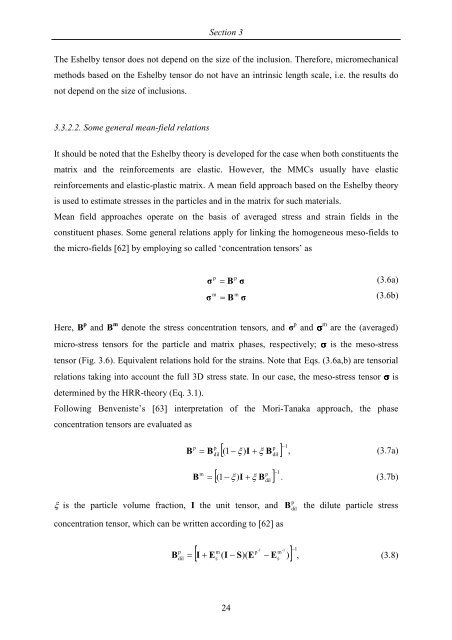dissertation global and local fracture properties of metal matrix ...
dissertation global and local fracture properties of metal matrix ...
dissertation global and local fracture properties of metal matrix ...
You also want an ePaper? Increase the reach of your titles
YUMPU automatically turns print PDFs into web optimized ePapers that Google loves.
Section 3<br />
The Eshelby tensor does not depend on the size <strong>of</strong> the inclusion. Therefore, micromechanical<br />
methods based on the Eshelby tensor do not have an intrinsic length scale, i.e. the results do<br />
not depend on the size <strong>of</strong> inclusions.<br />
3.3.2.2. Some general mean-field relations<br />
It should be noted that the Eshelby theory is developed for the case when both constituents the<br />
<strong>matrix</strong> <strong>and</strong> the reinforcements are elastic. However, the MMCs usually have elastic<br />
reinforcements <strong>and</strong> elastic-plastic <strong>matrix</strong>. A mean field approach based on the Eshelby theory<br />
is used to estimate stresses in the particles <strong>and</strong> in the <strong>matrix</strong> for such materials.<br />
Mean field approaches operate on the basis <strong>of</strong> averaged stress <strong>and</strong> strain fields in the<br />
constituent phases. Some general relations apply for linking the homogeneous meso-fields to<br />
the micro-fields [62] by employing so called ‘concentration tensors’ as<br />
24<br />
(3.6a)<br />
(3.6b)<br />
Here, B p <strong>and</strong> B m denote the stress concentration tensors, <strong>and</strong> σ p <strong>and</strong> σ m are the (averaged)<br />
micro-stress tensors for the particle <strong>and</strong> <strong>matrix</strong> phases, respectively; σ is the meso-stress<br />
tensor (Fig. 3.6). Equivalent relations hold for the strains. Note that Eqs. (3.6a,b) are tensorial<br />
relations taking into account the full 3D stress state. In our case, the meso-stress tensor σ is<br />
determined by the HRR-theory (Eq. 3.1).<br />
Following Benveniste’s [63] interpretation <strong>of</strong> the Mori-Tanaka approach, the phase<br />
concentration tensors are evaluated as<br />
ξ is the particle volume fraction, I the unit tensor, <strong>and</strong><br />
concentration tensor, which can be written according to [62] as<br />
B<br />
p<br />
dil<br />
σ<br />
σ<br />
p =<br />
m =<br />
B<br />
B<br />
p<br />
m<br />
σ<br />
σ<br />
[ ] 1 p −<br />
( 1 − ξ ) I +<br />
p p<br />
B B dil ξ<br />
= B<br />
dil<br />
[ ] 1 p −<br />
( 1−<br />
ξ ) I +<br />
m<br />
B ξ<br />
= B<br />
dil<br />
[ ] 1<br />
-1<br />
-1 −<br />
m<br />
p m<br />
I + Es<br />
( I − S)(<br />
E − s )<br />
= E<br />
, (3.7a)<br />
. (3.7b)<br />
p<br />
B dil the dilute particle stress<br />
, (3.8)
















